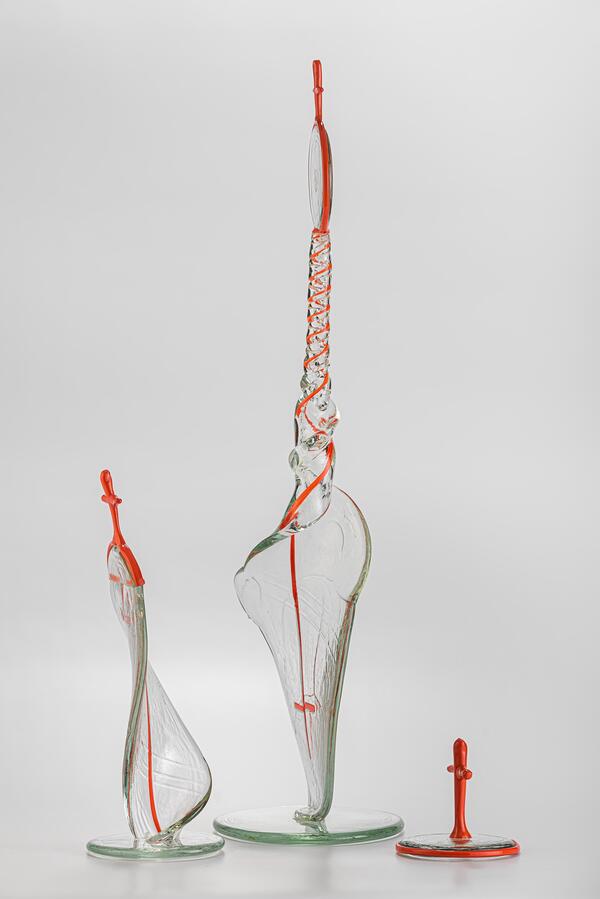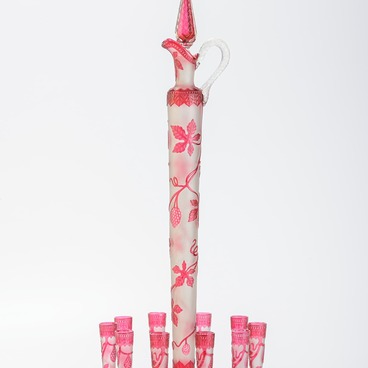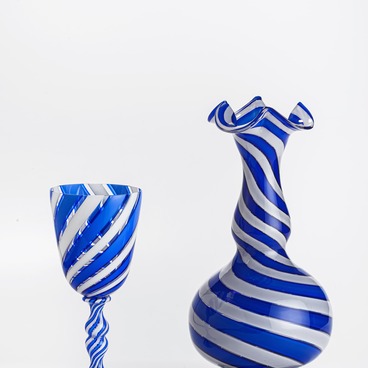The composition “Shikhan” is dedicated to the restoration of the Intercession Shikhansky Monastery. The central figure is an oval-shaped layer of glass with a red cane that is spirally twisted upwards. It is topped with a disc with a red cross. Inside the second figure, also oval in shape, there is another red glass cane — its upper part becomes a cross. The third item is a flat disc with a standing cross.
Hovik Grigorievich Manukyan drew his inspiration from a trip to the holy places of the Nikolsky district. The tour that made such an indelible impression on the artist was organized in 2006 during the International Symposium of Glass Artists.
The Intercession Shikhansky monastery was arranged for monks in the 1850s, but by the 1860s it had already been empty. In 1882, a women’s almshouse was built in its place, later — a convent. From 1890 to 1905, the ten-domed stone-built Trinity Cathedral appeared, followed by a settlement around it. In 1937, the monastery was closed, and by the 1970s, it was completely destroyed and plundered. Only the foundations of the cathedral and the monks’ graves had remained.
In 1993, a memorial sign was erected there, and in 2007, a wooden chapel in honor of St. Sergius of Radonezh was erected on Shikhan Mountain. Since 2010, monastic life has been revived in the monastery, new buildings have been built, and the territory has been taken care of.
The composition symbolically reflects the complex history of the monastery. The grim theme is emphasized by the lack of any extra decorations. All the items are free-blown. During the manufacturing process in a hot workshop, colorless glass was combined with red cross-shaped glass canes. The base and the finial of the central piece were glued cold, and a special glue was used. The work of a glass blower is similar to that of a sculptor, in which only burners, tongs, scissors, glass pipes and other hand tools are used. The time for creating the product was strictly limited by the cooling time of the glass mass.
The composition “Shikhan” was made by a team of glass blowers led by Viktor Sidorin.
The designer of the work Hovik Grigorievich Manukyan is a freelance artist and participant of many art symposiums. He graduated from the Yerevan Academy of Fine Arts and is currently living and working in Moscow.
Hovik Grigorievich Manukyan drew his inspiration from a trip to the holy places of the Nikolsky district. The tour that made such an indelible impression on the artist was organized in 2006 during the International Symposium of Glass Artists.
The Intercession Shikhansky monastery was arranged for monks in the 1850s, but by the 1860s it had already been empty. In 1882, a women’s almshouse was built in its place, later — a convent. From 1890 to 1905, the ten-domed stone-built Trinity Cathedral appeared, followed by a settlement around it. In 1937, the monastery was closed, and by the 1970s, it was completely destroyed and plundered. Only the foundations of the cathedral and the monks’ graves had remained.
In 1993, a memorial sign was erected there, and in 2007, a wooden chapel in honor of St. Sergius of Radonezh was erected on Shikhan Mountain. Since 2010, monastic life has been revived in the monastery, new buildings have been built, and the territory has been taken care of.
The composition symbolically reflects the complex history of the monastery. The grim theme is emphasized by the lack of any extra decorations. All the items are free-blown. During the manufacturing process in a hot workshop, colorless glass was combined with red cross-shaped glass canes. The base and the finial of the central piece were glued cold, and a special glue was used. The work of a glass blower is similar to that of a sculptor, in which only burners, tongs, scissors, glass pipes and other hand tools are used. The time for creating the product was strictly limited by the cooling time of the glass mass.
The composition “Shikhan” was made by a team of glass blowers led by Viktor Sidorin.
The designer of the work Hovik Grigorievich Manukyan is a freelance artist and participant of many art symposiums. He graduated from the Yerevan Academy of Fine Arts and is currently living and working in Moscow.





